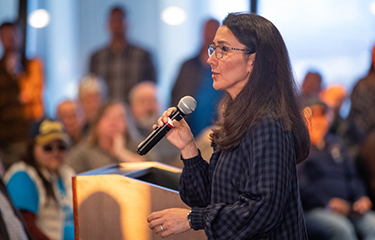NPFMC declines to set chum salmon bycatch limits, granting reprieve to US pollock trawlers

The North Pacific Fishery Management Council has adopted a plan that would set parameters on managing bycatch of chum salmon in the Alaska pollock industry, a move that sidestepped the placement of a hard cap on chum salmon bycatch.
The move comes as Alaska tribal leaders from the Yukon and Kuskokwim rivers regions filed a lawsuit on 10 April, asking the U.S. National Marine Fisheries Service review groundfish catch limits in the Bering Sea and Aleutian Islands. The tribes claim salmon bycatch from pollock fishing in the region has caused declines in the chum salmon population that have harmed the tribes’ ability to continue their subsistence fishery.
The NPFMC’s advisory panel recommended four potential actions regarding chum salmon bycatch, including keeping the status quo; implementing a strict hard-cap bycatch limits based on a number of factors, with the maximum allowed bycatch at roughly 54,000 chum salmon; implementing time-based or area-based closures; or instituting additional regulatory requirements for intertidal protected areas.
The pollock industry has been on the defensive against charges from a number of other fishing groups that its trawler bycatch has a negative impact on other species, including chum and chinook salmon, red king crab, and opilio crab. In January 2023, the NPFMC declined to take any action to limit pollock trawling,
While the move ultimately means the pollock fishery has avoided any hard cap for now, some council members said they were in favor of taking action to restore subsistence salmon fishery access to Alaska Native tribes.
“From my seat, this is now a humanitarian crisis. Three consecutive years of people of Western Alaska not having access to one of the most-important sources of food, one of the most important elements in their culture, one of the most-important parts of their lives is, to me, unimaginably devastating,” NPFMC Member Bill Tweit said.
Complicating the debate, chum salmon raised in hatcheries in Japan have been released in the same waters as Alaska chum salmon, and genetic analysis of chum salmon caught by pollock trawlers indicates most of the bycatch is Asian origin, not Alaskan.
The At-Sea Processors Association, which represents the commercial pollock fleet, has continued to push against any hard cap on chum salmon bycatch out of fear it would result in the pollock fishery being shut down completely. The organization's executive director, Stephanie Madsen, told the Alaska Beacon shutting down the fishery for chum bycatch without any controls over the difference between Asian and Alaskan chum salmon could wind up closing the fishery to protect pollock that trawlers aren’t catching.
“If it’s an overall cap, we don’t know whether we’re catching Asian hatchery fish or Western Alaska fish,” she said.
Some advocates for NPFMC action on the issue said they were disappointed by the council’s reluctance to move forward on bycatch caps, for chum salmon and more.
“This council seems to be prioritizing profits for the pollock fishery over all other interests,” SalmonState Executive Director Tim Bristol said. “Instead of addressing Alaskans’ urgent calls for action, they’re putting herring, king salmon, chum salmon, crab, halibut, and traditional ways of life on the chopping block so trawlers can keep trawling.”
Photo courtesy of SalmonState






Share